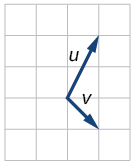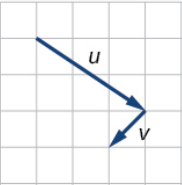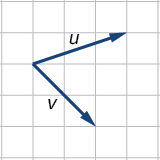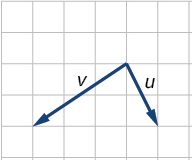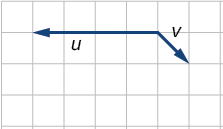7.3e: Exercises - Vectors in 2D
- Page ID
- 67822
A: Vector Overview
Exercise \(\PageIndex{A}\): Vector Overview
1. What are the characteristics of the letters that are commonly used to represent vectors?
2. How is a vector more specific than a line segment?
3. What are \(\hat{\mathbf i}\) and \(\hat{\mathbf j}\), and what do they represent?
4. What is component form?
5. When a unit vector is expressed as \(\left \langle a, b \right \rangle\) which letter is the coefficient of the \(\hat{\mathbf i}\) and which the \(\hat{\mathbf j}\)?
- Answers to odd exercises:
-
1. lowercase, bold letter, usually \(u, v, w\)
3. They are unit vectors. They are used to represent the horizontal and vertical components of a vector. They each have a magnitude of \(1\).
5. The first number always represents the coefficient of the \(\hat{\mathbf i}\) and the second represents the \(\hat{\mathbf j}\).
D: Perform Vector Operations Geometrically
Exercise \(\PageIndex{D}\): Perform Vector Operations Graphically
\( \bigstar \) Given \(\vecs v\) below, draw \(\vecs v\), \(\vecs {3v}\), and \(\dfrac{1}{2}v\).
10. \(\left \langle 2,-1 \right \rangle\)
11. \(\left \langle -1,4 \right \rangle\)
12. \(\left \langle -3,-2 \right \rangle\)
\( \bigstar \) Use the vectors shown to sketch \(\vecs u + \vecs v\), \(\vecs u − \vecs v\), and \(\vecs {2u}\).
|
13.
|
14.
|
15.
|
\( \bigstar \) Use the vectors shown to sketch \(\vecs{2u} + \vecs v\).
|
16.
|
17.
|
\( \bigstar \) Use the vectors shown to sketch \(\vecs u − \vecs{3v}\).
|
18.
|
19. |
- Answers to odd exercises:
-
11.
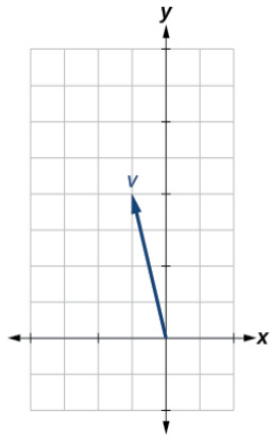
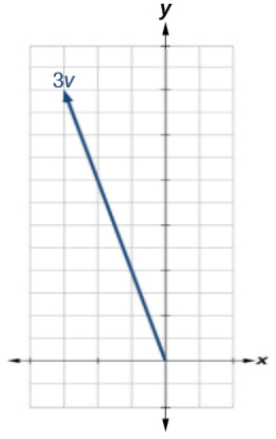
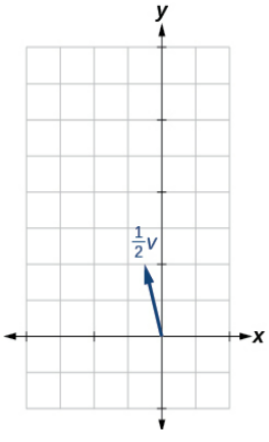
13.
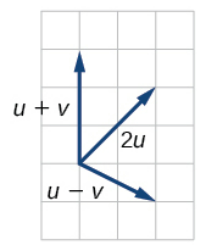
15.
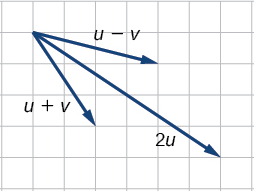
17.
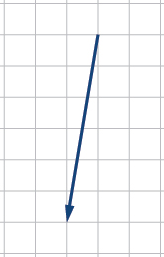
19.
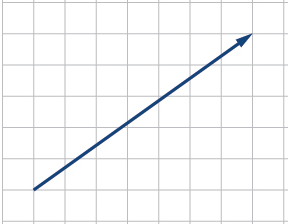
B: Construct a Vector Given a Graph or its Initial and Terminal Points
Exercise \(\PageIndex{B}\): Construct Vectors
\( \bigstar \) Write the vector shown in component form.
|
20.  |
21.
|
24. Given initial point \(P_1=(-3,1)\) and terminal point \(P_2=(5,2)\), write the vector \(\vecs v\) in component form.
25. Given initial point \(P_1=(6,0)\) and terminal point \(P_2=(-1,-3)\), write the vector \(\vecs v\) in component form.
26. Given initial point \(P_1=(2,1) \) and terminal point \(P_2=(-1,2)\)write the vector \(\vecs v\) in terms of \(\hat{\mathbf i}\) and \(\hat{\mathbf j}\), then draw the vector on the graph.
27. Given initial point \(P_1=(4,-1) \) and terminal point \(P_2=(-3,2)\), write the vector \(\vecs v\) in terms of \(\hat{\mathbf i}\) and \(\hat{\mathbf j}\). Draw the points and the vector on the graph.
28). Given initial point \(P_1=(3,3) \) and terminal point \(P_2=(-3,3)\), write the vector \(\vecs v\) in terms of \(\hat{\mathbf i}\) and \(\hat{\mathbf j}\). Draw the points and the vector on the graph.
- Answers to odd exercises:
-
21. \(\left \langle 4,1 \right \rangle\)
25. \(\left \langle -7, -3 \right \rangle \)
27. \(\vecs v\) = \( -7\hat{\mathbf i}+3\hat{\mathbf j}\)

C: Equal Vectors
Exercise \(\PageIndex{C}\): Compare Vectors
\( \bigstar \) Determine whether the two vectors \(\vecs u\) and \(\vecs v\) are equal, where \(\vecs u\) has an initial point \(P_1\) and a terminal point \(P_2\) and \( \vecs v\) has an initial point \(P_3\) and a terminal point \(P_4\).
31. \(P_1=(5,1), P_2=(3,-2), P_3=(-1,3), P4=(9,−4)\)
32. \(P_1=(2,-3), P_2=(5,1), P_3=(6,-1), P_4=(9,3)\)
33. \(P_1=(-1,-1), P_2=(-4,5), P_3=(-10,6), P_4=(-13,12)\)
34. \(P_1=(3,7), P_2=(2,1), P_3=(1,2), P_4=(-1,-4)\)
35. \(P_1=(8,3), P_2=(6,5), P_3=(11,8), P4=(9,10)\)
37. Given a vector with initial point \((5,2)\) and terminal point \((-1,-3)\), find an equivalent vector whose initial point is \((0,0)\). Write the vector in component form \(\left \langle a,b \right \rangle\).
38. Given a vector with initial point \((7,-1)\) and terminal point \((-1,-7)\), find an equivalent vector whose initial point is \((0,0)\). Write the vector in component form \(\left \langle a, b \right \rangle\).
39. Given a vector with initial point \((-4,2)\) and terminal point \((3,-3)\), find an equivalent vector whose initial point is \((0,0)\). Write the vector in component form \(\left \langle a,b \right \rangle\).
- Answers to odd exercises:
-
31. not equal 33. equal 35. equal 37. \(\left \langle -6,-5 \right \rangle\) 39. \(\left \langle 7,-5 \right \rangle\)
E: Perform Vector Operations Algebraically
Exercise \(\PageIndex{E}\)
\( \bigstar \) Use the given vectors to compute \( \vecs u + \vecs v \), \( \vecs u - \vecs v \), \( 2\vecs u - 3\vecs v\)
41. \( \vecs u = \left \langle -3, 4 \right \rangle, \vecs v = \left \langle -2, 1 \right \rangle \)
42. \( \vecs u = \left \langle 2, -3 \right \rangle, \vecs v = \left \langle 1, 5 \right \rangle \)
\( \bigstar \) Use the vectors \(u\vecs u = \hat{\mathbf i}+5\hat{\mathbf j}, \vecs v = -2\hat{\mathbf i}-3\hat{\mathbf j}, \vecs w = 4\hat{\mathbf i}-\hat{\mathbf j}\) to evaluate the following vector operations.
45. Find \(4 \vecs v + 2 \vecs u \)
46. Find \( \vecs u + ( \vecs v - \vecs w ) \)
- Answers to odd exercises:
-
41. \(\vecs u+\vecs v=\left \langle -5,5 \right \rangle, \vecs u- \vecs v=\left \langle -1,3 \right \rangle, 2 \vecs u-3 \vecs v=\left \langle 0,5 \right \rangle\)
45. \(-6\hat{\mathbf i}-2\hat{\mathbf j}\)
F: Find the Magnitude and Direction Angle of a Vector
Exercise \(\PageIndex{F}\)
51. Let \(\vecs a\) be a standard-position vector with terminal point \((−2,−4)\). Let \(\vecs b\) be a vector with initial point \((1,2)\) and terminal point \((−1,4)\). Find the magnitude of vector \(−3\vecs a+\vecs b−\left \langle 4, -15 \right \rangle.\)
52. Let \(\vecs a\) be a standard-position vector with terminal point at \((2,5)\). Let \(\vecs b\) be a vector with initial point \((−1,3)\) and terminal point \((1,0)\). Find the magnitude of vector \(\vecs a−3\vecs b+14\hat{\mathbf i}−14\hat{\mathbf j}.\)
\( \bigstar \) Find the direction angle \(θ∈[0,2π)\) for vector \(\vecs u\).
53. \( \vecs u=5\sqrt{2}\hat{\mathbf i}−5\sqrt{2}\hat{\mathbf j} \)
54. \( \vecs u=−\sqrt{3}\hat{\mathbf i}−\hat{\mathbf j} \)
\( \bigstar \) Find the magnitude and direction angle for the vector.
55. \(\left \langle 6,5 \right \rangle\)
56. \(\left \langle 0,4 \right \rangle\)
57. \(\left \langle -4,-6 \right \rangle\)
58. \(\left \langle 2,-5 \right \rangle\)
- Answers to odd exercises:
-
51. \(29\) 53. \(θ=\frac{7π}{4}\) 55. \( \| \vecs v \|=7.810, \theta =39.806^{\circ}\) 57. \( \| \vecs v \|=7.211, \theta =236.310^{\circ}\)
G: Find Vector components given its Magnitude and Direction
Exercise \(\PageIndex{G}\)
\( \bigstar \) Find the component form of vector \( \vecs u\), given its magnitude and the angle the vector makes with the positive x-axis. Give exact answers when possible.
|
61. \(‖ \vecs u‖=2, θ=30°\) 62. \(‖ \vecs u‖=6, θ=60°\) 63. \(‖ \vecs u‖=5, θ=90°\) |
64. \(‖ \vecs u‖=8, θ=π\) 65. \(‖ \vecs u‖=10, θ=\frac{5π}{6}\) 66. \(‖ \vecs u‖=50, θ=\frac{3π}{4}\) |
\( \bigstar \) Write the vector in standard unit vector form, given its magnitude and direction angle \( \theta \).
|
67. \( \| \vecs v \|=6, \theta =45^{\circ}\) 68. \( \| \vecs v \|=8, \theta =220^{\circ}\) |
69. \( \| \vecs v \|=2, \theta =300^{\circ}\) 70. \( \| \vecs v \|=5, \theta =135^{\circ}\) |
\( \bigstar \) Find the x and y components of a vector
71. Find the magnitude of the horizontal and vertical components of a vector with magnitude \(8\) pounds pointed in a direction of \(27^{\circ}\) above the horizontal. Round to the nearest hundredth.
72. Find the magnitude of the horizontal and vertical components of the vector with magnitude \(4\) pounds pointed in a direction of \(127^{\circ}\) above the horizontal. Round to the nearest hundredth.
73. Find the magnitude of the horizontal and vertical components of a vector with magnitude \(5\) pounds pointed in a direction of \(55^{\circ}\) above the horizontal. Round to the nearest hundredth.
74. Find the magnitude of the horizontal and vertical components of the vector with magnitude \(1\) pound pointed in a direction of \(8^{\circ}\) above the horizontal. Round to the nearest hundredth.
\( \bigstar \) Find components parallel and perpendicular to another item
75. Find the components parallel and perpendicular to a \(12^{\circ}\) inclined ramp on which a \(60\)-pound box is resting. Round to the nearest tenth.
76. Find the components parallel and perpendicular to \(8^{\circ}\) inclined ramp on which a \(25\)-pound box is resting. Round to the nearest tenth.
- Answers to odd exercises:
-
61. \( \vecs u=⟨\sqrt{3},1⟩\)
63. \( \vecs u=⟨0,5⟩\)
65. \( \vecs u=⟨−5\sqrt{3},5⟩\)
67. \(3\sqrt{2}\hat{\mathbf i}+3\sqrt{2}\hat{\mathbf j}\)69. \(\hat{\mathbf i}-\sqrt{3}\hat{\mathbf j}\)
71. \(x=7.13\) pounds, \(y=3.63\) pounds
73. \(x=2.87\) pounds, \(y=4.10\) pounds
75. perpendicular to ramp = \(58.7 lbs\), parallel to ramp = \(12.5 lbs\)
H: Unit Vectors
Exercise \(\PageIndex{H}\): Unit Vectors
81. A vector \( \vecs v\) has initial point \((−1,−3)\) and terminal point \((2,1)\). Find the unit vector in the direction of \( \vecs v\). Express the answer in component form.
82. A vector \( \vecs v\) has initial point \((−2,5)\) and terminal point \((3,−1)\). Find the unit vector in the direction of \( \vecs v\). Express the answer in component form.
\( \bigstar \) Find a unit vector in the same direction as the given vector.
|
83. \( \vecs b = -2\hat{\mathbf i} + 5\hat{\mathbf j}\) 84. \( \vecs a = 3\hat{\mathbf i} + 4\hat{\mathbf j}\) 85. \( \vecs d=-\dfrac{1}{3}\hat{\mathbf i}+\dfrac{5}{2}\hat{\mathbf j}\) |
86. \( \vecs c = 10\hat{\mathbf i} - \hat{\mathbf j}\) 87. \( \vecs u = -14\hat{\mathbf i} + 2\hat{\mathbf j}\) 88. \( \vecs u = 100\hat{\mathbf i} + 200\hat{\mathbf j}\) |
\( \bigstar \) Find vector \( \vecs v\) with the given magnitude and in the same direction as vector \( \vecs u\).
|
89. \( \| \vecs v \| \) = \(7\), \( \vecs u \) = \(\left \langle 3,4 \right \rangle\) 90. \( \| \vecs v \| \) = \(3\), \( \vecs u \) = \(\left \langle -2, 5 \right \rangle\) |
91. \( \| \vecs v \| \) = \(7\), \( \vecs u \) = \(\left \langle 3, -5 \right \rangle\) 92. \( \| \vecs v \| \) = \(10\), \( \vecs u \) = \(\left \langle 2, -1 \right \rangle\) |
93. Let \(\vecs v = 5\hat{\mathbf i} + 2\hat{\mathbf j} \). Find a vector that is twice the length and points in the opposite direction as \(\vecs v \).
94). Let \(\vecs v = -4\hat{\mathbf i} + 3\hat{\mathbf j} \). Find a vector that is halfthe length and points in the same direction as \(\vecs v \).
- Answers to odd exercises:
-
81. \(⟨\frac{3}{5},\frac{4}{5}⟩\)
83. \(-\dfrac{2\sqrt{29}}{29}\hat{\mathbf i}+\dfrac{5\sqrt{29}}{29}\hat{\mathbf j}\)
85. \(-\dfrac{2\sqrt{229}}{229}\hat{\mathbf i}+\dfrac{15\sqrt{229}}{229}\hat{\mathbf j}\)87. \(-\dfrac{7\sqrt{2}}{10}\hat{\mathbf i}+\dfrac{\sqrt{2}}{10}\hat{\mathbf j}\)
89. \(\vecs v \) = \( ⟨ \frac{21}{5},\frac{28}{5}⟩\)
91. \(\vecs v=⟨\frac{21\sqrt{34}}{34},−\frac{35\sqrt{34}}{34}⟩\)
93. \(-10\hat{\mathbf i}-4\hat{\mathbf j}\)
I: Mixed practice
Exercise \(\PageIndex{I}\): Vector Mixed Practice
\( \bigstar \) Consider points \(P(−1,3), Q(1,5),\) and \(R(−3,7)\). Determine the requested vectors and express each of them
a. in component form and
b. by using the standard unit vectors.
|
101. \(\vecd{PQ}\) 102. \(\vecd{PR}\) 103. \(\vecd{QP}\) 104. \(\vecd{RP}\) 105. \(\vecd{PQ}+\vecd{PR}\) |
106). \(\vecd{PQ}−\vecd{PR}\) 107. \(2\vecd{PQ}−2\vecd{PR}\) 108. \(2\vecd{PQ}+\frac{1}{2}\vecd{PR}\) 109. The unit vector in the direction of \(\vecd{PQ}\) 110. The unit vector in the direction of \(\vecd{PR}\) |
111. The vector \( \vecs v\) has initial point \(P(1,0)\) and terminal point \(Q\) that is on the y-axis and above the initial point. Find the coordinates of terminal point \(Q\) such that the magnitude of the vector \( \vecs v\) is \(\sqrt{5}\).
112. The vector \( \vecs v\) has initial point \(P(1,1)\) and terminal point \(Q\) that is on the x-axis and left of the initial point. Find the coordinates of terminal point \(Q\) such that the magnitude of the vector \( \vecs v\) is \(\sqrt{10}\).
For the following exercises, use the given vectors \( \vecs a\) and \( \vecs b\).
a. Determine the vector sum \( \vecs a+ \vecs b\) and express it in both the component form and by using the standard unit vectors.
b. Find the vector difference \( \vecs a− \vecs b\) and express it in both the component form and by using the standard unit vectors.
c. Determine the vectors \( \vecs {2a}, \vecs {−b,}\) and \( \vecs {2a−b}.\) Express the vectors in both the component form and by using standard unit vectors.
113. \( \vecs a=2\hat{\mathbf i}+\hat{\mathbf j}, \quad \vecs b=\hat{\mathbf i}+3\hat{\mathbf j} \)
114. \( \vecs a=2\hat{\mathbf i}, \quad \vecs b=−2\hat{\mathbf i}+2\hat{\mathbf j} \)
- Answers to odd exercises:
-
101. \(a. \vecd{PQ}=⟨2,2⟩; \qquad b. \vecd{PQ}=2\hat{\mathbf i}+2\hat{\mathbf j}\)
103. \(a. \vecd{QP}=⟨−2,−2⟩; \qquad b. \vecd{QP}=−2\hat{\mathbf i}−2\hat{\mathbf j}\)
105. \(a. \vecd{PQ}+\vecd{PR}=⟨0,6⟩; \qquad b. \vecd{PQ}+\vecd{PR}=6\hat{\mathbf j}\)
107. \(a. 2\vecd{PQ}−2\vecd{PR}=⟨8,−4⟩; \qquad b. 2\vecd{PQ}−2\vecd{PR}= 8\hat{\mathbf i}−4\hat{\mathbf j} \)
109. \(a. ⟨\frac{\sqrt{2}}{2},\frac{\sqrt{2}}{2}⟩; \qquad b. \frac{\sqrt{2}}{2}\hat{\mathbf i}+\frac{\sqrt{2}}{2} \hat{\mathbf j} \)
111. \(Q(0,2)\)
113. \(a.\, \vecs a+\vecs b=⟨3,4⟩=3\hat{\mathbf i}+4\hat{\mathbf j} \quad \) \(b.\, \vecs a−\vecs b=⟨1,−2⟩=\hat{\mathbf i}−2\hat{\mathbf j} \\ \)
\( \quad c.\, 2\vecs a=⟨4,2⟩=4\hat{\mathbf i}+2\hat{\mathbf j}, \quad −\vecs b=⟨−1,−3⟩=−\hat{\mathbf i}−3\hat{\mathbf j}, \quad 2\vecs a−\vecs b=⟨3,−1⟩=3\hat{\mathbf i}−\hat{\mathbf j}\)
J: Find Resultant Vectors
Exercise \(\PageIndex{J}\): Applications of Vectors
121. A woman leaves home and walks \(3\) miles west, then \(2\) miles southwest. How far from home is she, and in what direction must she walk to head directly home?
122. A boat leaves the marina and sails \(6\) miles north, then \(2\) miles northeast. How far from the marina is the boat, and in what direction must it sail to head directly back to the marina?
123. A man starts walking from home and walks \(4\) miles east, \(2\) miles southeast, \(5\) miles south, \(4\) miles southwest, and \(2\) miles east. How far has he walked? If he walked straight home, how far would he have to walk?
124. A woman starts walking from home and walks \(4\) miles east, \(7\) miles southeast, \(6\) miles south, \(5\) miles southwest, and \(3\) miles east. How far has she walked? If she walked straight home, how far would she have to walk?
125. A man starts walking from home and walks \(3\) miles at \(20^{\circ}\) north of west, then \(5\) miles at \(10^{\circ}\) west of south, then \(4\) miles at \(15^{\circ}\) north of east. If he walked straight home, how far would he have to the walk, and in what direction?
126. A woman starts walking from home and walks \(6\) miles at \(40^{\circ}\) north of east, then \(2\) miles at \(15^{\circ}\) east of south, then \(5\) miles at \(30^{\circ}\) south of west. If she walked straight home, how far would she have to walk, and in what direction?
127). Two children are throwing a ball back and forth straight across the back seat of a car. The ball is being thrown \(10\) mph relative to the car, and the car is traveling \(25\) mph down the road. If one child doesn't catch the ball, and it flies out the window, in what direction does the ball fly (ignoring wind resistance)?
128. Two children are throwing a ball back and forth straight across the back seat of a car. The ball is being thrown \(8\) mph relative to the car, and the car is traveling \(45\) mph down the road. If one child doesn't catch the ball, and it flies out the window, in what direction does the ball fly (ignoring wind resistance)?
129. An airplane is heading north at an airspeed of \(600\) km/hr, but there is a wind blowing from the southwest at \(80\) km/hr. How many degrees off course will the plane end up flying, and what is the plane’s speed relative to the ground?
130. An airplane is heading north at an airspeed of \(500\) km/hr, but there is a wind blowing from the northwest at \(50\) km/hr. How many degrees off course will the plane end up flying, and what is the plane’s speed relative to the ground?
131. An airplane needs to head due north, but there is a wind blowing from the southwest at \(60\) km/hr. The plane flies with an airspeed of \(550\) km/hr. To end up flying due north, how many degrees west of north will the pilot need to fly the plane?
132. An airplane needs to head due north, but there is a wind blowing from the northwest at \(80\) km/hr. The plane flies with an airspeed of \(500\) km/hr. To end up flying due north, how many degrees west of north will the pilot need to fly the plane?
133. Suppose a body has a force of \(10\) pounds acting on it to the right, \(25\) pounds acting on it ─\(135^{\circ}\) from the horizontal, and \(5\) pounds acting on it directed \(150^{\circ}\) from the horizontal. What single force is the resultant force acting on the body?
134. Suppose a body has a force of \(10\) pounds acting on it to the right, \(25\) pounds acting on it upward, and \(5\) pounds acting on it \(45^{\circ}\) from the horizontal. What single force is the resultant force acting on the body?
135. Suppose a body has a force of \(3\) pounds acting on it to the left, \(4\) pounds acting on it upward, and \(2\) pounds acting on it \(30^{\circ} \) from the horizontal. What single force is needed to produce a state of equilibrium on the body? Draw the vector.
136. The condition of equilibrium is when the sum of the forces acting on a body is the zero vector. Suppose a body has a force of \(2\) pounds acting on it to the right, \(5\) pounds acting on it upward, and \(3\) pounds acting on it \(45^{\circ}\) from the horizontal. What single force is needed to produce a state of equilibrium on the body?
137. As part of a video game, the point \((5,7)\) is rotated counterclockwise about the origin through an angle of \(35^{\circ}\). Find the new coordinates of this point.
138. As part of a video game, the point \((7,3)\) is rotated counterclockwise about the origin through an angle of \(40^{\circ}\). Find the new coordinates of this point.
139. A \(50\)-pound object rests on a ramp that is inclined \(19^{\circ}\). Find the magnitude of the components of the force parallel to and perpendicular to (normal) the ramp to the nearest tenth of a pound.
- Answers to odd exercises:
-
121. \(4.635\) miles, \(17.764^{\circ}\) N of E
123. \(17\) miles, \(10.318\) miles
125. Distance: \(2.868\), Direction: \(86.474^{\circ}\) North of West, or \(3.526^{\circ}\) West of North
127. \(21.801^{\circ}\), relative to the car’s forward direction
129. \(4.924^{\circ}\), 659 km/hr
131. \(4.424^{\circ}\)
133. \(19.35\) pounds, \(231.54^{\circ}\) from the horizontal
135. \(5.1583\) pounds, \(-75.8^{\circ}\) from the horizontal
137. \((0.081,8.602)\)
139. parallel: \(16.28\), perpendicular: \(47.28\) pounds
Real-World Applications II
Exercise \(\PageIndex{A}\): Applications of Vectors
Solve the following vector applications.
|
145. The speed of an object is the magnitude of its related velocity vector. A football thrown by a quarterback has an initial speed of \(70\) mph and an angle of elevation of \(30°\). Determine the velocity vector in mph and express it in component form. (Round to two decimal places.)
|
|
|
146. A baseball player throws a baseball at an angle of \(30°\) with the horizontal. If the initial speed of the ball is \(100\) mph, find the horizontal and vertical components of the initial velocity vector of the baseball. (Round to two decimal places.) |
|
| 147. A bullet is fired with an initial velocity of \(1500\) ft/sec at an angle of \(60°\) with the horizontal. Find the horizontal and vertical components of the velocity vector of the bullet. (Round to two decimal places.) | |
|
148. A 65-kg sprinter exerts a force of \(798\) N at a \(19°\) angle with respect to the ground on the starting block at the instant a race begins. Find the horizontal component of the force. (Round to two decimal places.) |
|
|
149. A guy-wire supports a pole that is \(75\) ft high. One end of the wire is attached to the top of the pole and the other end is anchored to the ground \(50\) ft from the base of the pole. Determine the horizontal and vertical components of the force of tension in the wire if its magnitude is \(50\) lb. (Round to the nearest integer.)
|
|
|
150. A telephone pole guy-wire has an angle of elevation of \(35°\) with respect to the ground. The force of tension in the guy-wire is \(120\) lb. Find the horizontal and vertical components of the force of tension. (Round to the nearest integer.) |
|
|
151. An airplane is flying in the direction of \(43°\) east of north (also abbreviated as \(N43E\)) at a speed of \(550\) mph. A wind with speed \(25\) mph comes from the southwest at a bearing of \(N15E\). What are the ground speed and new direction of the airplane?
|
|
|
152. A boat is traveling in the water at \(30\) mph in a direction of \(N20E\) (that is, \(20°\) east of north). A strong current is moving at \(15\) mph in a direction of \(N45E\). What are the new speed and direction of the boat?
|
|
|
153. Two forces, a horizontal force of \(45\) lb and another of \(52\) lb, act on the same object. The angle between these forces is \(25°\). Find the magnitude and direction angle from the positive x-axis of the resultant force that acts on the object. (Round to two decimal places.)
|
|
|
154. Two forces, a vertical force of \(26\) lb and another of \(45\) lb, act on the same object. The angle between these forces is \(55°\). Find the magnitude and direction angle from the positive x-axis of the resultant force that acts on the object. (Round to two decimal places.)
|
|
|
155. Three forces act on object. Two of the forces have the magnitudes \(58\) N and \(27\) N, and make angles \(53°\) and \(152°\), respectively, with the positive x-axis. Find the magnitude and the direction angle from the positive x-axis of the third force such that the resultant force acting on the object is zero. (Round to two decimal places.)
|
|
|
156. Three forces with magnitudes 80 lb, 120 lb, and 60 lb act on an object at angles of \(45°, 60°\) and \(30°\), respectively, with the positive x-axis. Find the magnitude and direction angle from the positive x-axis of the resultant force. (Round to two decimal places.)
|
|
|
157. A 50-lb weight is hung by a cable so that the two portions of the cable make angles of \(40°\) and \(53°\), respectively, with the horizontal. Find the magnitudes of the forces of tension \( \vecs T_1\) and \( \vecs T_2\) in the cables if the resultant force acting on the object is zero. (Round to two decimal places.) |
|
|
158. A 62-lb weight hangs from a rope that makes the angles of \(29°\) and \(61°\), respectively, with the horizontal. Find the magnitudes of the forces of tension \( \vecs T_1\) and \( \vecs T_2\) in the cables if the resultant force acting on the object is zero. (Round to two decimal places.)
|
|
|
159. A 1500-lb boat is parked on a ramp that makes an angle of \(30°\) with the horizontal. The boat’s weight vector points downward and is a sum of two vectors: a horizontal vector \( \vecs v_1\) that is parallel to the ramp and a vertical vector \( \vecs v_2\) that is perpendicular to the inclined surface. The magnitudes of vectors \( \vecs v_1\) and \( \vecs v_2\) are the horizontal and vertical component, respectively, of the boat’s weight vector. Find the magnitudes of \( \vecs v_1\) and \( \vecs v_2\). (Round to the nearest integer.)
|
|
|
160. An 85-lb box is at rest on a \(26°\) incline. Determine the magnitude of the force parallel to the incline necessary to keep the box from sliding. (Round to the nearest integer.) |
- Answers to odd exercises:
-
145. \(⟨60.62,35⟩\)
147. The horizontal and vertical components are \(750\) ft/sec and \(1299.04\) ft/sec, respectively.
149. The two horizontal and vertical components of the force of tension are \(28\) lb and \(42\) lb, respectively.
151. The new ground speed of the airplane is \(572.19\) mph; the new direction is \(N41.82E.\)
153. The magnitude of resultant force is \(94.71\) lb; the direction angle is \(13.42°\).
155. The magnitude of the third vector is \(60.03\)N; the direction angle is \(259.38°\).
157. \(∥ \vecs T_1∥=30.13lb, ∥ \vecs T_2∥=38.35lb\)
159. \( \| \vecs {v1} \| = 750 \) lb, \( \| \vecs {v2} \| = 1299 \) lb



